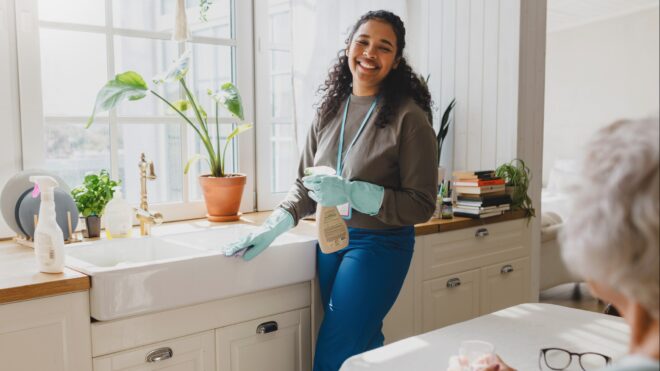
PICKLES. Need I say more?
OK, fine. I adore pickles, and I’d heard that they’re incredibly easy to make. But for some reason, I’d never made them. I preferred to just savor them when they came on a burger (mmm), or save them for last when they came on the side (those miniature ones! Mmm). They’re good in practically every form: fried, sliced, or whole. And while other vegetables make delicious guest-star pickles, regular ol’ pickles — that is, pickled cucumbers — are clearly the star of the show.
Anyway, I think we can all (mostly) agree about pickles. Recently, I learned that it’s possible to make homemade pickles in the fridge with just four ingredients: cucumbers, vinegar, salt, and dill. Throw them together in a glass jar, wait a few hours, and bam! PICKLES.
Well, that’s all I needed to hear. I went to the grocery store, I came home, and I made pickles. And then I put them on a sandwich. Guess what? It was delicious.
By making my own pickles, I’m participating in a centuries-old culinary tradition. Pickles have been around since way before the time of the Bible. Pickling vegetables is a way of preserving them, which was extra important when refrigerators were nothing but a distant dream. In the old days, people routinely fermented their pickles in saltwater brine for weeks. They’d stay fresh for months, as long as they were kept in a cool, dark place. When vegetables are fermented in saltwater brine, it’s impossible for bacteria to spoil the food. The fact that the same brine is delicious is just a bonus. Picklebacks, anyone?
Making traditional dill pickles is an involved process that, frankly, I still have no interest in. But nowadays, lazy home cooks like myself can easily make “quick pickles” in the fridge. They last for about three weeks, instead of months, but that’s OK, because they take only about five minutes to make, and they’re ready within hours (hence the name). There is no canning involved.
Cucumbers, by themselves, are a no-go for me; I’ll pick them off anything I’m eating. But in pickle form? I will eat them until, for the next 24 hours, every burp reminds me of their deliciousness. Gross, yes, but also, mmm.
Here we go!
Pickle Prep

I have a confession to make: Technically, I have pickled something once before. Once upon a time, I made pickled tomatoes, and I made them when I found myself with a surplus of tomatoes from a farm that I was working at. I don’t really like tomatoes, but I was excited that I’d helped to grow a whole field full of them, so I was trying to get inventive.
The only ingredients in these pickles were salt, vinegar, garlic, and pepper. They were not delicious, but again, I don’t like tomatoes. I was really hoping that my regular pickles would turn out better.

I don’t like cucumbers, either, but thanks to some sort of sorcery — maybe dill? — I love PICKLES. I went to the store to get some cucumbers and the other ingredients that I needed.
(I did not get garlic, because I forgot to, but I didn’t really need it after all.)
The Ingredients

I bought Persian cucumbers, ground dill, and mustard seed. I already had white vinegar, salt, and bay leaf on hand. You’ll notice that bay leaf was on my list of ingredients, but not pictured here. That’s because I completely forgot to add it until later.
I spent around $12 on these three ingredients.

You can use various kinds of cucumbers for pickling, but the most common is the kirby cucumber, which is a smaller variety than your regular cucumbers, typically 3 to 6 inches long. But when I went to Trader Joe’s, the only cucumbers they had were English cucumbers, otherwise known as “ridiculously long cucumbers that look more like a weapon than a vegetable” – and Persian cucumbers, which are cute and little. I went with Persian. Keep in mind that both seedless and Persian cucumbers will result in a less-crunchy pickle than kirby cucumbers.
I used a quart-size Mason jar for my pickles.
Step 1: Cut 'Em Up

First, cut four cucumbers into inch-wide slices. I think you can also pickle whole cucumbers, but every recipe I saw instructed me to chop the cukes, so that’s what I did. I’m not the pickle expert here.
I had one cucumber left over. I threw it in the trash, because YUCK (just kidding — I gave it away).
Step 2: Make the Brine

Next, I measured 1/2 cup of white vinegar.
I should mention that I cobbled these measurements together from a bunch of different recipes. Some of them advise you to add both vinegar and water, but my favorite food blog, Smitten Kitchen, says that the water isn’t necessary because the cucumbers themselves contain enough water. So I didn’t add any water.
Also, lots of recipes involve making brine on the stovetop. You add vinegar and water and salt, and sometimes sugar, and heat it before pouring it onto the cucumbers. Again, Smitten Kitchen was like, “Nah, not necessary,” so I didn’t do that, either.
You can also use apple cider vinegar or rice vinegar for the brine, if you want to experiment.

Next, I added 1 1/2 teaspoons of salt. I only had this fancy Hawaiian black lava salt on hand. I have no idea how it ended up in my kitchen, and it made my brine look all black, but salt is salt, I guess?

And then I added a teaspoon of mustard seed.

And then I added a teaspoon of dill weed.

And then I put the cucumbers in the jar. I think I did this out of order, but oh well!
I shook the jar to mix all the ingredients. The vinegar level looked low, so I added more. But upon additional reading, I learned that the liquid level would rise as the salt drew the water out of the cucumbers, so I poured some of it back out. Was that right? I don’t know.

A little while later, I realized that I had entirely forgotten about the bay leaf. So I ran back down to the kitchen and put that in the jar, too, and shook it up some more.
Step 3: Wait Entirely Too Long

Then I waited and waited, impatient to taste PICKLES. My girlfriend had fried some chicken the night before — because she’s a real cook, you see — and I was dying to make a fried chicken sandwich with pickles on top, which is one of my favorite meals.
You can eat your pickles in as soon as one to two hours. That’s why they are called “quick pickles.” But it feels like forever, you know? Patience is hard.
Step 4: Put Them on a Sandwich

Two hours later, and finally, PICKLES! I put them on a sandwich, and it was so, so good. Like Smitten Kitchen promised, the liquid level of the pickles rose to cover them. They turned out great. Even though I was prepared for them to be less crunchy than I’m used to, they were crisp and sour and perfect.

Mmm.
Step 5: Die Happy

Nothing more to see here. Just me and my pickles, until the end of time. I’d call this one a success.




